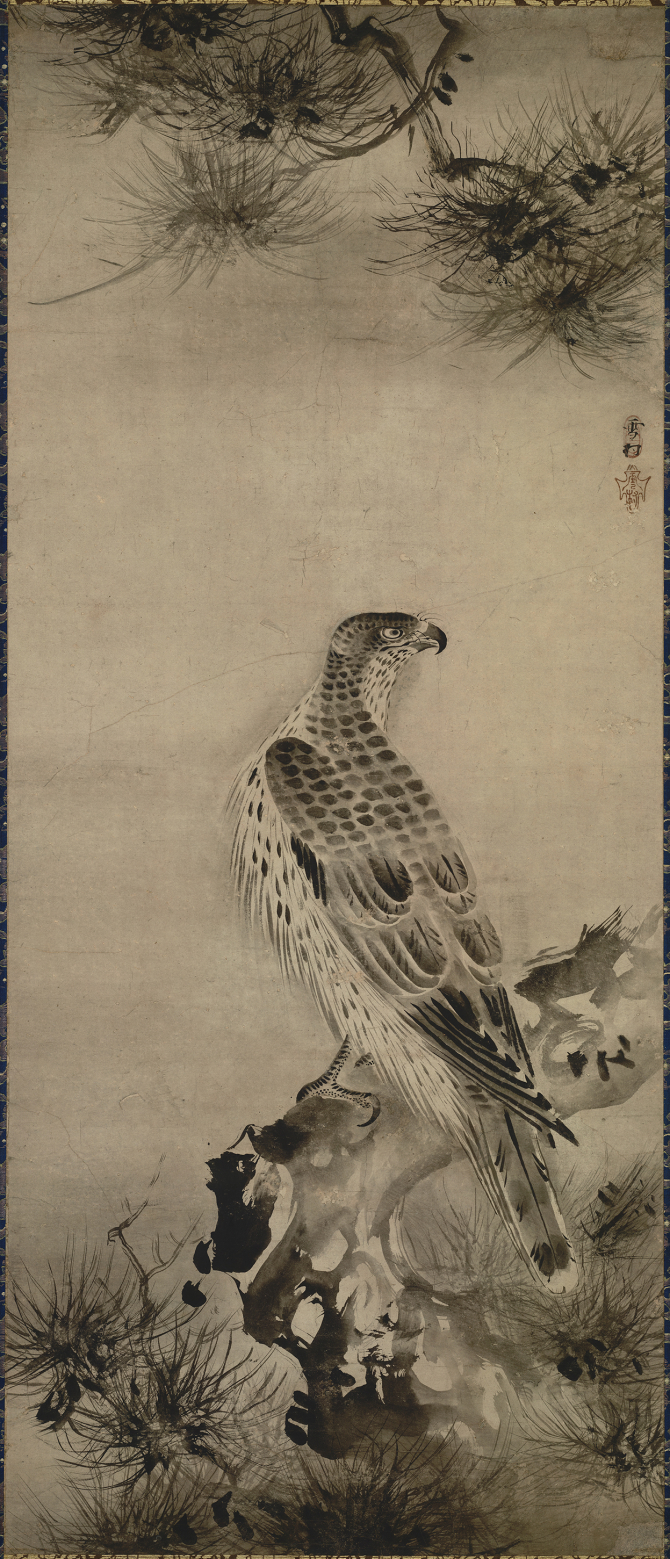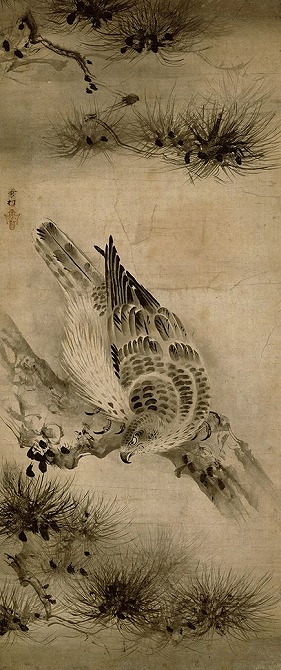 | ||
| Completed scroll prior to calligraphy |
There are additional pictures below the documentation of the originals that I based the piece on as well as some other photos of the completed piece.
Hawks and Pines
A Japanese Scroll
This is a Millrind scroll for a person
with a Japanese persona during the late Muromachi period. It is based
on a Japanese painting called “Hawks and Pines” by Sesson Shukei.
Although the actual date of the piece is unknown, the artist lived
from 1504-1589 during the Muromachi period in Japan. The original is
actually two separate hanging scrolls. The hawk that I used for a
reference for the top of the scroll is supposed to be hung on the
left and the one on the bottom is supposed to be on the right (Sadao
& Wada, 2003). I originally found the two scrolls when looking at
the Tokyo National Museum website and have since found them in other
books of Japanese art. I would like to request that the judges kindly
evaluate the piece solely on the painting and not the calligraphy as
that was done by a different artist.
The original paintings were 126.5 cm high and 53.5 cm wide (or 49.8” x 21”) (Sadao & Wada, 2003). I was unable to obtain paper of the desired quality in this dimension and reduced the size of the painting proportionately.
Westerners refer to papers for Japanese ink painting as “rice paper” even though they have nothing to do with rice. Japanese papers were usually made from sandalwood, bamboo, mulberry, cotton or linen (Frame, 2002, p. 18).
The paper that I chose to work with was a hot press cotton watercolor paper. I chose this paper for its fine grain and smooth surface. The paper is absorbent enough to handle the amount of water that is needed for large areas of ink wash, but is fine enough to do detailed work without a lot of excessive bleeding.
Ink in Japan is made from either pine carbon or oil carbon, and glue. The inks varied in color from brown tones to bluish. Japanese inks are available in a stick form which must be ground on a smooth surface with a slight tooth to it (usually slate). After grinding the ink, water must be added. I have found the ink stick to be inconsistent and at times may leave a gritty residue. For this piece I chose to work with a bottled, liquid ink to keep consistency and have more predictable results (Frame, 2002, p. 12-13). Shading effects are created by adding more or less water to the ink.
The originals were two separate scrolls which I decided to combine into one unique piece that would be to the recipient’s liking. The original pieces do not have calligraphy as this one does. As previously stated, I was not the calligrapher for this piece, but it was translated into Japanese and Kanji was used to add to the authenticity of the piece. There are examples of scrolls with painted images and calligraphy on them dating back to at least the 8th century (Sadao & Wada, 2003).
I have not found evidence for the use of pencils in Japanese sketching in period. Sketches were done with ink directly on paper. One example that I found of a sketch showed the artist simply folded his paper, drew a single line, and created the rest of the artwork from that line (Yukio, 1960). I chose to do a basic sketch in pencil first to create the layout of the branches and to determine the placement of the hawks. From this basic outline I then added my ink.
I used sable hair and goat hair paintbrushes to apply the ink. Many Asian brushes are made from wolf, goat and hog hair set in a hollow bamboo handle (Gair, 1995, p. 115). The goat hair brushes were soft and wide which allowed for an even wash over larger areas. I used the sable brushes because that is what I owned and was more familiar with.
The hawks chosen were appropriate for the recipient as they have a martial arts background. Paintings featuring birds of prey were “popular among military men, and often featured steely-eyed hawks poised for flight, an image suggestive of the turbulence of the late Muromachi years” (Sadao & Wada, 2003, p. 150).
In the future, if I were to do a similar piece, I would like to avoid the pencil sketches and create purely with ink. Consistency with stick ink may improve with additional practice.
References
Frame, S.(2002). Japanese Ink Painting: Beginner’s Guide to Sumi-e. New York. Sterling Publishing Company, Inc.
Gair, A. (Ed.). (1995) Artist’s Manual: A Complete Guide to Painting and Drawing Materials and Techniques. San Francisco, CA: Harper Collins.
Sadao, T.S., & Wada, S. (2003). Discovering the Arts of Japan: A Historical Overview. Tokyo, Japan. Kodansha International.
The TNM Collection (2011). In Tokyo National Museum. Retrieved from http://www.tnm.go.jp.
Yukio, Y. (Ed.). (1960) Art Treasures of Japan. Tokyo, Japan. Kokusai Bunka Shinkokai.
The original paintings were 126.5 cm high and 53.5 cm wide (or 49.8” x 21”) (Sadao & Wada, 2003). I was unable to obtain paper of the desired quality in this dimension and reduced the size of the painting proportionately.
Westerners refer to papers for Japanese ink painting as “rice paper” even though they have nothing to do with rice. Japanese papers were usually made from sandalwood, bamboo, mulberry, cotton or linen (Frame, 2002, p. 18).
The paper that I chose to work with was a hot press cotton watercolor paper. I chose this paper for its fine grain and smooth surface. The paper is absorbent enough to handle the amount of water that is needed for large areas of ink wash, but is fine enough to do detailed work without a lot of excessive bleeding.
Ink in Japan is made from either pine carbon or oil carbon, and glue. The inks varied in color from brown tones to bluish. Japanese inks are available in a stick form which must be ground on a smooth surface with a slight tooth to it (usually slate). After grinding the ink, water must be added. I have found the ink stick to be inconsistent and at times may leave a gritty residue. For this piece I chose to work with a bottled, liquid ink to keep consistency and have more predictable results (Frame, 2002, p. 12-13). Shading effects are created by adding more or less water to the ink.
The originals were two separate scrolls which I decided to combine into one unique piece that would be to the recipient’s liking. The original pieces do not have calligraphy as this one does. As previously stated, I was not the calligrapher for this piece, but it was translated into Japanese and Kanji was used to add to the authenticity of the piece. There are examples of scrolls with painted images and calligraphy on them dating back to at least the 8th century (Sadao & Wada, 2003).
I have not found evidence for the use of pencils in Japanese sketching in period. Sketches were done with ink directly on paper. One example that I found of a sketch showed the artist simply folded his paper, drew a single line, and created the rest of the artwork from that line (Yukio, 1960). I chose to do a basic sketch in pencil first to create the layout of the branches and to determine the placement of the hawks. From this basic outline I then added my ink.
I used sable hair and goat hair paintbrushes to apply the ink. Many Asian brushes are made from wolf, goat and hog hair set in a hollow bamboo handle (Gair, 1995, p. 115). The goat hair brushes were soft and wide which allowed for an even wash over larger areas. I used the sable brushes because that is what I owned and was more familiar with.
The hawks chosen were appropriate for the recipient as they have a martial arts background. Paintings featuring birds of prey were “popular among military men, and often featured steely-eyed hawks poised for flight, an image suggestive of the turbulence of the late Muromachi years” (Sadao & Wada, 2003, p. 150).
In the future, if I were to do a similar piece, I would like to avoid the pencil sketches and create purely with ink. Consistency with stick ink may improve with additional practice.
References
Frame, S.(2002). Japanese Ink Painting: Beginner’s Guide to Sumi-e. New York. Sterling Publishing Company, Inc.
Gair, A. (Ed.). (1995) Artist’s Manual: A Complete Guide to Painting and Drawing Materials and Techniques. San Francisco, CA: Harper Collins.
Sadao, T.S., & Wada, S. (2003). Discovering the Arts of Japan: A Historical Overview. Tokyo, Japan. Kodansha International.
The TNM Collection (2011). In Tokyo National Museum. Retrieved from http://www.tnm.go.jp.
Yukio, Y. (Ed.). (1960) Art Treasures of Japan. Tokyo, Japan. Kokusai Bunka Shinkokai.


Original scrolls by Sesson 16th centruy (Muromachi Period) 126.5 x 53.5
Tokyo National Museum
(These should actually be switched left and right, unfortunately I wasn't able to do so after placing the pictures on the page.)


Close ups of each hawk that I painted
 |
| Painting taped to a board to prevent warping or rippling from the wet ink |
 |
| Completed scroll with calligraphy, wording, and translation by Lady Minamoto no Taikawa Saiaiko |